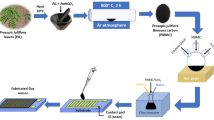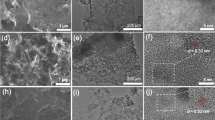Abstract
China is the largest walnut producer with the largest planting area and output in the world. The discarded walnut shell (WS) is often burned or incinerated, which not only causes environmental pollution, but also may exacerbate the greenhouse effect. In order to realize resource utilization, WS was prepared into N-doped carbon materials through a simple and environmentally friendly hydrothermal reaction at 180°C. In order to further improve the N content of the product, peptone and WS were added to the hydrothermal reaction together to prepare carbon materials with higher N content. The gas-sensing properties of two biomass carbon materials were compared. The results show that higher N doping in carbon material derived from walnut shell contributes to higher selectivity for formaldehyde (CH2O) and hydrogen peroxide (H2O2) at room temperature. Compared with the carbon material derived from pure WS, the responses of higher-N-doped carbon materials to CH2O and H2O2 was increased by 12 and 14 times, respectively. And the high-N-doped carbon material can detect a low concentration of H2O2 (0.29 ppm). This work provides a reference for the green utilization of fruit shells and the development of sensing materials.








Similar content being viewed by others
References
E. Meloni, M. Caldera, V. Palma, V. Pignatelli, and V. Gerardi, Soot abatement from biomass boilers by means of open-cell foams filters. Renew. Energy 131, 745–754 (2019).
A.M. Petersen, O.V. Okoro, F. Chireshe, T. Moonsamy, and J.F. Görgens, Systematic cost evaluations of biological and thermochemical processes for ethanol production from biomass residues and industrial off-gases. Energy Convers. Manag. 243, 114398 (2021).
K. Papanikola, T. Nisotakis, M. Sofra, and G. Lyberatos, Characterization, classification and stabilization of industrial wastes for hazard property HP3: flammable self-heating; assessment and evaluation of 50 industrial wastes. J. Hazard Mater. 403, 123665 (2021).
D. De Clercq, Z. Wen, F. Fei, L. Caicedo, K. Yuan, and R. Shang, Interpretable machine learning for predicting biomethane production in industrial-scale anaerobic co-digestion. Sci. Total Environ. 712, 134574 (2020).
T.K. Naqvi, A. Bajpai, M.S.S. Bharati, M.M. Kulkarni, A.M. Siddiqui, V.R. Soma, and P.K. Dwivedi, Ultra-sensitive reusable SERS sensor for multiple hazardous materials detection on single platform. J. Hazard Mater. 407, 124353 (2021).
L. Siebert, N. Wolff, N. Ababii, M.I. Terasa, O. Lupan, A. Vahl, V. Duppel, H. Qiu, M. Tienken, M. Mirabelli, V. Sontea, F. Faupel, L. Kienle, and R. Adelung, Facile fabrication of semiconducting oxide nanostructures by direct ink writing of readily available metal microparticles and their application as low power acetone gas sensors. Nano Energy 70, 104420 (2020).
P.T. Hernández, A.J.T. Naik, E.J. Newton, S.M.V. Hailes, and I.P. Parkin, Assessing the potential of metal oxide semiconducting gas sensors for illicit drug detection markers. J. Mater. Chem. A 2, 8952–8960 (2014).
S. Mahajan and S. Jagtap, Metal-oxide semiconductors for carbon monoxide (CO) gas sensing: a review. Appl. Mater. Today 18, 100483 (2020).
C. Yu, J.H. He, X.F. Cheng, H.Z. Lin, H. Yu, and J.M. Lu, An Ion-in-conjugation-boosted Organic semiconductor gas sensor operating at high temperature and immune to moisture. Angew. Chem. Int. Ed Engl. 60, 15328–15334 (2021).
E.H. Kwon, M. Kim, C.Y. Lee, M. Kim, and Y.D. Park, Metal-organic-framework-decorated carbon nanofibers with enhanced gas sensitivity when incorporated into an organic semiconductor-based gas sensor. ACS Appl. Mater. Interfaces 14, 10637–10647 (2022).
K. Suematsu, W. Harano, T. Oyama, Y. Shin, K. Watanabe, and K. Shimanoe, Pulse-driven semiconductor gas sensors toward ppt level toluene detection. Anal. Chem. 90, 11219–11223 (2018).
S.S. Niavol, M. Budde, A. Papadogianni, M. Heilmann, H.M. Moghaddam, C.M. Aldao, G. Ligorio, E.J.W. List-Kratochvil, J.M.J. Lopes, N. Barsan, O. Bierwagen, and F. Schipani, Conduction mechanisms in epitaxial NiO/Graphene gas sensors. Sens. Actuators B Chem. 325, 128797 (2020).
R. Ghanbari, R. Safaiee, H.S. Mohammad, M.G. Mohammad, and Z.K. Horastani, Graphene decorated with silver nanoparticles as a low-temperature methane gas sensor. ACS Appl. Mater. Interfaces 11, 21795–21806 (2019).
Y. Wang, M. Yang, W. Liu, L. Dong, D. Chen, and C. Peng, Gas sensors based on assembled porous graphene multilayer frameworks for DMMP detection. J. Mater. Chem. C 7, 9248–9256 (2019).
B. Song, X. Zhang, J. Huang, X. Cheng, Z. Deng, Y. Xu, L. Huo, and S. Gao, Porous Cr2O3 architecture assembled by nano-sized cylinders/ellipsoids for enhanced sensing to trace H2S gas. ACS Appl. Mater. Interfaces 14, 22302–22312 (2022).
W. Li, L. He, X. Bai, L. Liu, M. Ikram, H. Lv, M. Ullah, M. Khan, K. Kan, and K. Shi, Enhanced NO2 sensing performance of S-doped biomorphic SnO2 with increased active sites and charge transfer at room temperature. Inorg. Chem. Front. 7, 2031–2042 (2020).
Q. Sun, Z. Wu, Z. Qin, X. Chen, C. Zhang, B. Cao, H. Duan, and J. Zhang, A dog nose-inspired high-performance NH3 gas sensor of biomass carbon materials with a pleated structure derived from rose tea. J. Mater. Chem. A 10, 14326–14335 (2022).
J. Leichtweis, S. Silvestri, and E. Carissimi, New composite of pecan nutshells biochar-ZnO for sequential removal of acid red 97 by adsorption and photocatalysis. Biomass Bioenergy 140, 105648 (2020).
Q. Sun, Z. Wu, B. Cao, X. Chen, C. Zhang, T. Shaymurat, H. Duan, J. Zhang, and M. Zhang, Gas sensing performance of biomass carbon materials promoted by nitrogen doping and p-n junction. Appl. Surf. Sci. 592, 153254 (2022).
M. Choi, Y. Kang, I. Lim, and Y. Chang, Structural characterization of cellulose obtained from extraction wastes of graviola (Annona muricata) leaf. Prev. Nutr. Food Sci. 23, 166–170 (2018).
S. Naduparambath and E. Purushothaman, Sago seed shell: determination of the composition and isolation of microcrystalline cellulose (MCC). Cellulose 23, 1803–1812 (2016).
X. Song, W. He, H. Qin, S. Yang, and S. Wen, Fused deposition modeling of poly (lactic acid)/macadamia composites—thermal. Mech. Prop. Scaffolds Mater. 13, 258 (2020).
F. Ghasemi, M. Jalali, A. Abdollahi, S. Mohammadi, Z. Sanaee, and S. Mohajerzadeh, A high performance supercapacitor based on decoration of MoS2/reduced graphene oxide with NiO nanoparticles. RSC Adv. 7, 52772–52781 (2017).
Y. Niu, R. Wang, W. Jiao, G. Ding, L. Hao, F. Yang, and X. He, MoS2 graphene fiber based gas sensing devices. Carbon 95, 34–41 (2015).
W. Qiao, M. Huda, Y. Song, S.-H. Yoon, Y. Korai, I. Mochida, O. Katou, H. Hayashi, and K. Kawamoto, Carbon fibers and films based on biomass resins. Energy Fuels 19, 2576–2582 (2005).
W. Wang, K. Qu, X. Zhang, M. Teng, and Z. Huang, Integrated instillation technology for the synthesis of a pH-responsive sodium alginate/biomass charcoal soil conditioner for controlled release of humic acid and soil remediation. J. Agric. Food Chem. 69, 13386–13397 (2021).
K. Chaudhary, K. Bhakuni, N. Mogha, P. Venkatesu, and D.T. Masram, Sustainable solvothermal conversion of waste biomass to functional carbon material: extending its utility as a biocompatible cosolvent for lysozyme. ACS Biomater. Sci. Eng. 6, 4881–4892 (2020).
X. Qi, N. Liu, and Y. Lian, Carbonaceous microspheres prepared by hydrothermal carbonization of glucose for direct use in catalytic dehydration of fructose. RSC Adv. 5, 17526–17531 (2014).
M. Kim, S.-C. Jee, S. Shinde, B.M. Mistry, R.G. Saratale, G.D. Saratale, G.S. Ghodake, D. Kim, J. Sung, and A. Kadam, Green-synthesis of anisotropic peptone-silver nanoparticles and its potential application as anti-bacterial agent. Polymers 11, 271 (2019).
L. Zhang, W. Chai, W. Li, K. Semple, N. Yin, W. Zhang, and C. Dai, Intumescent-grafted bamboo charcoal: a natural nontoxic fire-retardant filler for polylactic acid (PLA) composites. ACS Omega 6, 26990–27006 (2021).
Y. Fu, X. Zhang, K. Zhang, Y. Bian, B. Yang, Identification of amino acids and their hydrates by terahertz spectroscopy. 11, (2018)
E. Yagmur, Y. Gokce, S. Tekin, N.I. Semerci, and Z. Aktas, Characteristics and comparison of activated carbons prepared from oleaster (Elaeagnus angustifolia L.) fruit using KOH and ZnCl2. Fuel 267, 117232 (2020).
Y. Dou, X. Liu, K. Yu, X. Wang, W. Liu, J. Liang, and C. Liang, Biomass porous carbon derived from jute fiber as anode materials for lithium-ion batteries. Diam. Relat. Mater. 98, 107514 (2019).
T. Thenrajan, S. Selvasundarasekar, S. Kundu, and J. Wilson, Novel electrochemical sensing of catechins in raw green tea extract via a trimetallic zeolitic imidazolate fibrous framework. ACS Omega 7, 19754–19763 (2022).
S. Liu, Z. Rao, R. Wu, Z. Sun, Z. Yuan, L. Bai, W. Wang, H. Yang, and H. Chen, Fabrication of microcapsules by the combination of biomass porous carbon and polydopamine for dual self-healing hydrogels. J. Agric. Food Chem. 67, 1061–1071 (2019).
A. Raghu, K. Karuppanan, and B. Pullithadathil, Highly sensitive, temperature-independent oxygen gas sensor based on anatase TiO2 nanoparticle grafted, 2D mixed valent VOx nanoflakelets. ACS Sens. 3, 1811–1821 (2018).
Y. Cui, Q. Huo, H. Chen, S. Chen, S. Wang, J. Wang, L. Chang, L. Han, and W. Xie, Biomass carbon magnetic adsorbent constructed by one-step activation method for the removal of Hg0 in flue gas. ACS Omega 7, 9244–9253 (2022).
C. Zhang, W. Song, Q. Ma, L. Xie, X. Zhang, and H. Guo, Enhancement of CO2 capture on biomass-based carbon from black locust by KOH Activation and ammonia modification. Energy Fuels 30, 4181–4190 (2016).
A. Xukeer, Z. Wu, Q. Sun, F. Zhong, M. Zhang, M. Long, and H. Duan, Enhanced gas sensing performance of perovskite YFe1−xMnxO3 by doping manganese ions. RSC Adv. 10, 30428–30438 (2020).
Y. Lu, M. Meyyappan, and J. Li, Trace detection of hydrogen peroxide vapor using a carbon-nanotube-based chemical sensor. Small 7, 1714–1718 (2011).
D.-J. Lee, S.-W. Choi, and Y.T. Byun, Room temperature monitoring of hydrogen peroxide vapor using platinum nanoparticles-decorated single-walled carbon nanotube networks. Sens. Actuators B Chem. 256, 744–750 (2018).
A.L. Verma, S. Saxena, G.S.S. Saini, V. Gaur, and V.K. Jain, Hydrogen peroxide vapor sensor using metal-phthalocyanine functionalized carbon nanotubes. Thin Solid Films 519, 8144–8148 (2011).
T. Liu, H. Wang, and M. Zhang, Fabrication of a solid H2O2 vapor sensor using Cu(II) chelating chitosan as catalyst and PVA/NaNO2 as electrolyte. J. Mater. Sci. Mater. Electron. 31, 12561–12569 (2020).
N. Yamazoe and K. Shimanoe, Theory of power laws for semiconductor gas sensors. Sens. Actuators B Chem. 128, 566–573 (2008).
M. Epifani, J. Prades, E. Comini, E. Pellicer, M. Avella, P. Siciliano, G. Faglia, A. Cirera, R. Scotti, F. Morazzoni, and J. Morante, The role of surface oxygen vacancies in the NO2 sensing properties of SnO2 nanocrystals. J. Phys. Chem. C 112, 19540–19546 (2008).
Q. Sun, Z. Wu, Y. Cao, J. Guo, M. Long, H. Duan, and D. Jia, Chemiresistive sensor arrays based on noncovalently functionalized multi-walled carbon nanotubes for ozone detection. Sens. Actuators B Chem. 297, 126689 (2019).
N. Näther, H. Henkel, A. Schneider, and M.J. Schöning, Investigation of different catalytically active and passive materials for realising a hydrogen peroxide gas sensor. Phys. Status Solidi A 206, 449–454 (2009).
Acknowledgments
This research was funded by the National Natural Science Foundation of China (21964016, 61864011), the Natural Science Foundation of Xinjiang Uygur Autonomous Region (2019D01C019), the Natural Science Foundation of Department of Education Xinjiang Uygur Autonomous Region (XJEDU2020Y004), the Youth Science Foundation of Guizhou Province Education Ministry (QJHKY [2019]115), and the Tianshan Innovation Team Program of Xinjiang Uygur Autonomous Region (2020D14038).
Author information
Authors and Affiliations
Corresponding author
Ethics declarations
Conflict of interest
The authors declare that they have no conflicting financial interests or personal relationships that could have appeared to influence the work reported in this paper.
Additional information
Publisher's Note
Springer Nature remains neutral with regard to jurisdictional claims in published maps and institutional affiliations.
Rights and permissions
Springer Nature or its licensor (e.g. a society or other partner) holds exclusive rights to this article under a publishing agreement with the author(s) or other rightsholder(s); author self-archiving of the accepted manuscript version of this article is solely governed by the terms of such publishing agreement and applicable law.
About this article
Cite this article
Liu, L.X., Wu, Z.F., Sun, Q.H. et al. Preparation of Carbon Material Derived from Walnut Shell and Its Gas-Sensing Properties. J. Electron. Mater. 52, 3092–3102 (2023). https://doi.org/10.1007/s11664-023-10218-y
Received:
Accepted:
Published:
Issue Date:
DOI: https://doi.org/10.1007/s11664-023-10218-y




